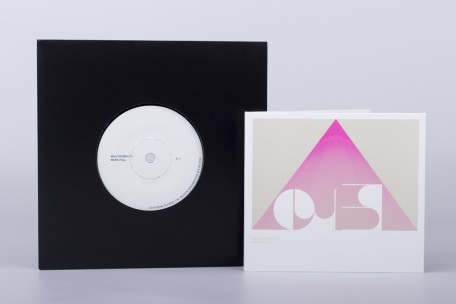multistability bundle
mark fell
multistability bundle
now available on the raster-noton online store: »multistability« cd in a bundle with a limited 7" single which contains the same note data: played forwards from edge to centre on side a; backwards from centre to edge on side b. THE TRACKS ON THE 7" SINGLE ARE EXCLUSIVELY AVAILABLE ON VINYL, NOT AS DIGITAL DOWNLOAD. for a personal statement by the artist on the 7" record please see below.
the latest project from sheffield based artist and electronic musician mark fell, »multistability«, is primarily an exploration of erratic and non-regular rhythmic patterns. drawing equally from his work with snd and his many solo projects fell’s most recent work promotes a minimal complexity; combining meticulous synthetic chordal layering with convoluted, chaotic yet fundamentally engaging temporal structures.
in the field of gestalt psychology, the term "multistability" refers to the effect where one is unable to perceive a single stable object within complex or ambiguous patterns. a famous example is the necker cube – a wire frame with no depth cues that oscillates between front back orientations. the term is also found in systems theory where it describes a condition that is neither stable nor instable, where a system switches between different states. fell takes these as a starting point for his project, developing compositional structures and strategies that transform and transcend the familiar; structures that refuse to accept parental advice.
split into two halves the album contains two versions of itself. using what fell describes as "extremely basic" pattern generating systems, passages reappear throughout... yet these are applied and manoeuvred into parallel versions of themselves – often different sounds and parameters are explored producing no singular or resolved arrangement.
in his recent works, fell’s process has been influenced by his collaborative encounters with friend and fellow musician yasunao tone - particularly tone’s approach to ideas concerning intentionality and time within the context of musical practices. in fell’s work, deliberate actions are layered, and distorted; manipulated to produce unforeseen and often extraordinary aesthetic outcomes... documented here in the form of 17 related pieces.
above all »multistablity« should be understood in light of fell’s claim that "music is a technology for constructing an experience of time". here, in musical form, fell aims to disrupt familiar temporal divisions and structures; and investigate non-repetitive musical process.
mark fell:
"after a recommendation by my friend yasunao tone, I read Husserl’s 'Phenomenology of Internal Time Consciousness' and became interested in his uses of music to illustrate the relationship between past, present and future. around the same time I came across the work of slovakian mathematician Metod Saniga who deals with 'psychopathological' experiences of space and time. Saniga has developed a mathematical model which accommodates the feeling of time standing still, speeding up, going in reverse, infinity and other 'non-normal' encounters with time associated with drug use, near death experiences and neurological disorders.
music composition is often thought of as the positioning of sounds in a temporal plane, and the vast majority music composition softwares follow this paradigm. it is also true of how music is recorded and distributed music on vinyl, tape, compact disc and mp3. the difference between these formats is usually described in terms of sound quality, but for me the most important difference is in their treatment of time - how they store and give access to temporal material. in the case of vinyl the observer can see directly where the needle is - there is no abstract representation of the needle's place in the duration of the piece - it is actually there. for me, the appeal of vinyl is not to do with warmth of sound quality, or its volatility, but in its ‘concrete’ treatment of time.
I had heard that it is possible to master a record to play from centre to edge. this technique was often favoured for recordings of classical music as the increased dynamic range at the outer edge of the disc is ideal for playback of musical crescendos. I considered making a record with a sound file that played forwards on side 1, from edge to centre; and backwards on side 2, from centre to edge. but this simple reversal of sound was not that interesting, I was more concerned with the reversal of ‘time’ at an abstract level. if I go for a walk, on my journey back the objects I encounter do not appear to be reversed, they are the same object just in reverse order. I decided therefore to construct a simple sequence of music where a list of timed events triggered sounds in a given order. I played these as forwards on side a and backwards on side b. here the music is backwards but the sounds themselves - the objects - are forwards.
in this sense the 7" record explores the interplay between three treatments of time: 1, the ordering and reversal of musical notes; 2, the direction of sound playback; and 3, the journey of the needle from the edge to the centre of the record and back again.
I hope you enjoy listening to this record."

